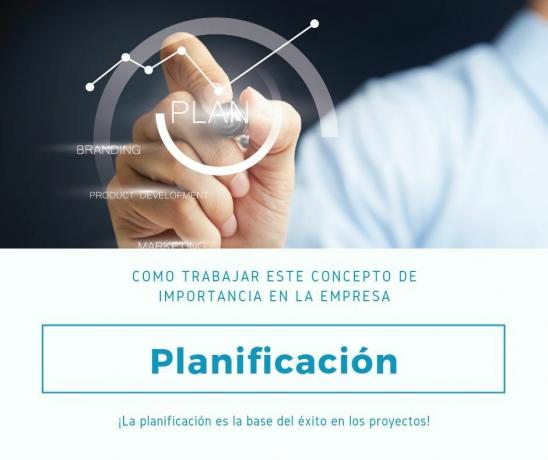The planning It can be defined as a well-considered process with a methodical and structured execution, in order to obtain a specific objective, the planning in a slightly broader sense, it could have more than one objective, so that the same planning organized could give, through the execution of several equal or complementary tasks, a series of goals. The greater the degree of planning, the easier it will be to achieve the maximum objectives with the least effort.
In a complementary way, we can say that the planning It is a process by which people establish a series of steps and parameters to follow before starting a project, in order to obtain the best possible results. It should be noted that it must be carried out in a methodical, structured and organized manner in an expanded manner with different complementary activities and steps to follow, setting delivery dates and distributing according to the hours of realization.
Advertisements

In this article you will find:
Phases of the planning process
The planning phases or steps are general guidelines, however, in each administrative management some of these phases may differ, depending on the complexity of the project.
Advertisements
However, the planning phases are a guide to follow, adaptable to the needs of any type of organization:
identify the problem
The first phase could be considered more of a pre-phase, but it is essential since before planning it is necessary to identify the problem, analyzing it at the root. Minimizing the problem or seeing it only in a general way, can bring more difficulties associated or derived from it in the future, however, the correct identification of a conflict in the company can help to find the best solutions.
Advertisements
It is mainly about carrying out an analysis of the existing problems, making a deep initial emphasis of the needs from the root, in a few words it is about making a count of what is there, what is not there and the factors that influence it, taking into account the interests of the people. Mainly this is obtained through the use of interviews, observations, surveys, meetings and historical documentation.
A simulated example: A project for the realization of a cart or racing cart where 5 people are involved, as the designers spend their days outside disagree about what the finish and paint should be, for which they submit it for consultation with the other members of the group and in turn generate a series of examples. After a few days and different meetings, a joint decision was made and the following steps were taken planning phases.
Advertisements
Be alert to opportunities
Detecting possible opportunities is the starting point of the planning process, evaluating the internal and external environment of the company from a broad perspective. itself, to identify potential future opportunities, from an objective and realistic point of view, taking into account the strengths and weaknesses of the company. company.
To do this, it must be clear what problems it has to solve and what benefits it will generate, reasonably analyzing each of the opportunities.
Advertisements
For harold koontz The identification of opportunities must be in the light of: the market, the competition, the wishes of the clients, the strengths and the weaknesses of their own.
Set objectives and goals
Once the problems and possible opportunities have been identified, the next planning phase is to identify objectives and goals. for the entire company and then determining activities for each work area, of what must be done in the short, medium and long term.
These objectives represent the results that are expected to be obtained, the achievement of which being the end of the planned project; For this, it is necessary to establish a strategic planning, determining the policies, rules, procedures, budgets and work programs.
Management can break down the general objectives into more specific objectives and goals for each area or department involved in the process.
For harold koontz the objectives and goals should respond to: "Where we would like to be, what we want to do and when."
Planning premises considerations
The next phase is to identify the planning premises that are decisive for planning, Harold Koontz (2012) defines these premises as “Assumptions about the environment in which the plan will be developed.” (p. 114).
This consideration makes it possible to establish forecasts, the definition of the basic policies to be applied and the entity's plans; In this way, situations such as market behavior, sales volume, prices, costs, taxes, profitability, etc. can be provided.
Harold Koontz (2012), expresses that this phase must respond to the principle of the planning premises, in which “The more the individuals in charge of planning understand and agree to use consistent planning premises, the better the coordinated planning of the enterprise will be.” (P. 115).
Develop alternative solutions
Once we know the problem, we must think of all the possible solutions, a greater number of possible solutions will give more possibilities to solve it in the most effective way. When devising solutions, a good alternative is to use the "brainstorming" method or brainstorming.
It is at this stage that the planning and programming. Therefore, the resources of the project will be organized to carry it out through the creation of solutions that accommodate an outlining of ideas, or a commonly used method such as brainstorming. ideas.
A series of important aspects for the project enter into this phase and will be mentioned below:
- The project is the most important thing at all times, so it is necessary to be clear about its nature and foundation, an example:
Project "Let's assemble a cart to compete", an activity to be carried out on weekends during the different competitions that take place along a hill on the outskirts of the city. the foundation of this project is based on the need to find fun for the weekends, as well as the distraction of all who are part of the home.
- The objectives must be clearly stated to understand what you want to achieve and must be general and specific, an example:
General objective:
- The car is made to participate in the races every weekend.
Specific objectives:
- Generate a greater sense of fun for children and other members of the project.
- Spend different times away from home.
- Encourage the children who are part of the project to improve every day and make new designs.
- Methodology and activities are two processes of great importance since with this the best way (method) to carry out will be chosen, for example:
Regarding the methodology, it can be done in a playful way with the purpose of seeking one's own enjoyment, or it can be done open way where everyone benefits in this regard, in a participatory way where each of the members is part of some activity.
As for the activities, workshops, internet consultations, trips to different workshops, driving tests, project exposure are carried out.
- Resources are varied and refer to human, material, spatial, and financial resources. Each one of them is an essential part to achieve the objectives, which is why they must be used and cared for in the best way.
- Timing is the time resource that is available to perform each task, starting from the most general to the most specific. For this, some resources are used, such as planning, schedules and schedules.

Choose the most suitable alternative
As mentioned in the previous step, a larger number of possible solutions will make it easier to choose. the most appropriate to our needs, and taking into account the resources and means of which we have.
For this, an assessment must be made in accordance with the premises and goals, examining the weak and strong points to determine which are the most viable alternatives.
However, regardless of the alternative to choose, it will also imply constant supervision and control to ensure that it develops according to plan.
Formulate derivative plans
Even when an action plan is already defined, it is necessary to establish alternative plans necessary to achieve said general plan.
It could be said that these are plans for the development of more specific activities such as planning the purchase of materials, hiring and training of personnel, among others.
Quantify plans through budgets
A plan is not complete if it has not been quantified through a budget, management must work on agreement with the finance department, to identify how many resources or how much is available for execution of the same.
For this, a reasonable assessment must be made of how much it costs to execute the project, to avoid overdrafting the budget and compromising the viability and profitability of the project.
Execute the planned alternative
This is undoubtedly the most important part of planning, or rather, planning itself, execute the action plan to solve the problem in the most efficient way possible, with a methodical system and well planned.
Planning in the company, detects possible problems even before they occur, it is the best way to make a company prosper safely to achieve the objectives set. If, in addition, this approach is carried out taking human resources into account, and involving them for a common objective, success is assured.
It is the phase of performance or put into practice, there will come true what has been designed and created on paper for so long, for this, certain considerations must be taken into account:
- The organization of all financial and material resources, so that there is no deficit in middle of the execution and bring delays that will harm the project and damage the perfect planning.
- Mutual motivation is essential, so that all members do what corresponds to each one in the best, fast and efficient way.
- Make sure that each member agrees on what corresponds to them and considers that they are on the right track.
- Adjust the program if there are delays on the part of any of the members of the group.
- Maintain the best attitude.
Example: The last meeting was held to start the project, where each team member carried out a count of all the parts that he needed in his part of the project, ignoring the painter since he belongs to the last phase of realization, once finished it was determined that everything was complete and in order. The question was asked if everyone was in agreement and happy with what was about to start, where they all stated that they were very happy and anxious.
For the next few days everyone worked efficiently achieving everything expected during the execution.
Evaluation and control
In this process of planning an assessment of what has been done is given, in the opinion of each of the participants or of those who will receive the project. It should be noted that throughout the project, continuous evaluations are carried out to determine the advance, as well as at the end to determine if the objectives have been achieved, for this a series of Steps:
- Data collection: observations, questions and interviews.
- Analysis of the workers: Each one must determine if the work carried out meets their own expectations.
- Emission of judgments, assessment and proposals to improve what has been done.
Evaluation and control is necessary in planning, since plans, however well formulated and coordinated they may be, are still susceptible to failures and unforeseen events, therefore, it is necessary to make modifications and adjustments that direct the loaves, to the efficient achievement of the objectives and silver goals.
Bibliographic references:
Harold Koontz, et al, (2012) "Administration. A Global and Business Perspective”; Mexico. McGRAW-HILL/Interamericana Editores S.A. de C.V.


